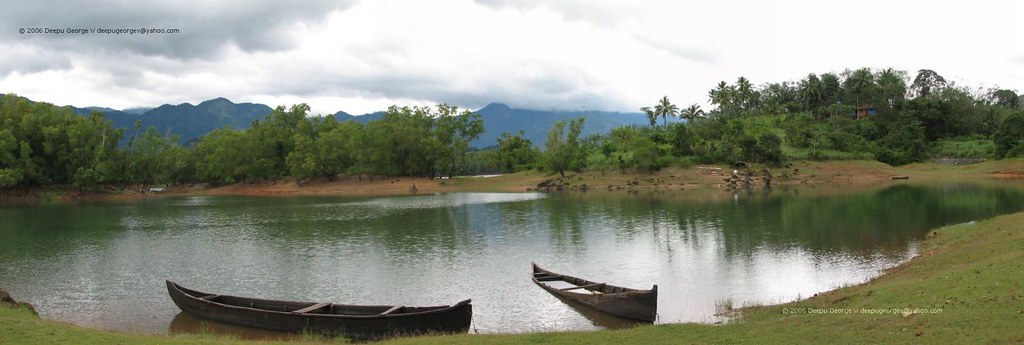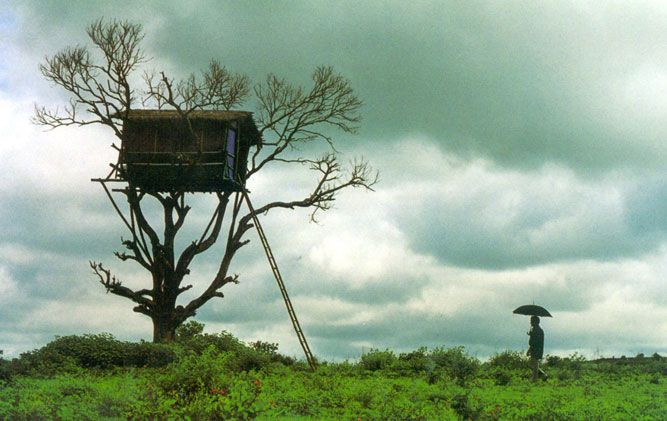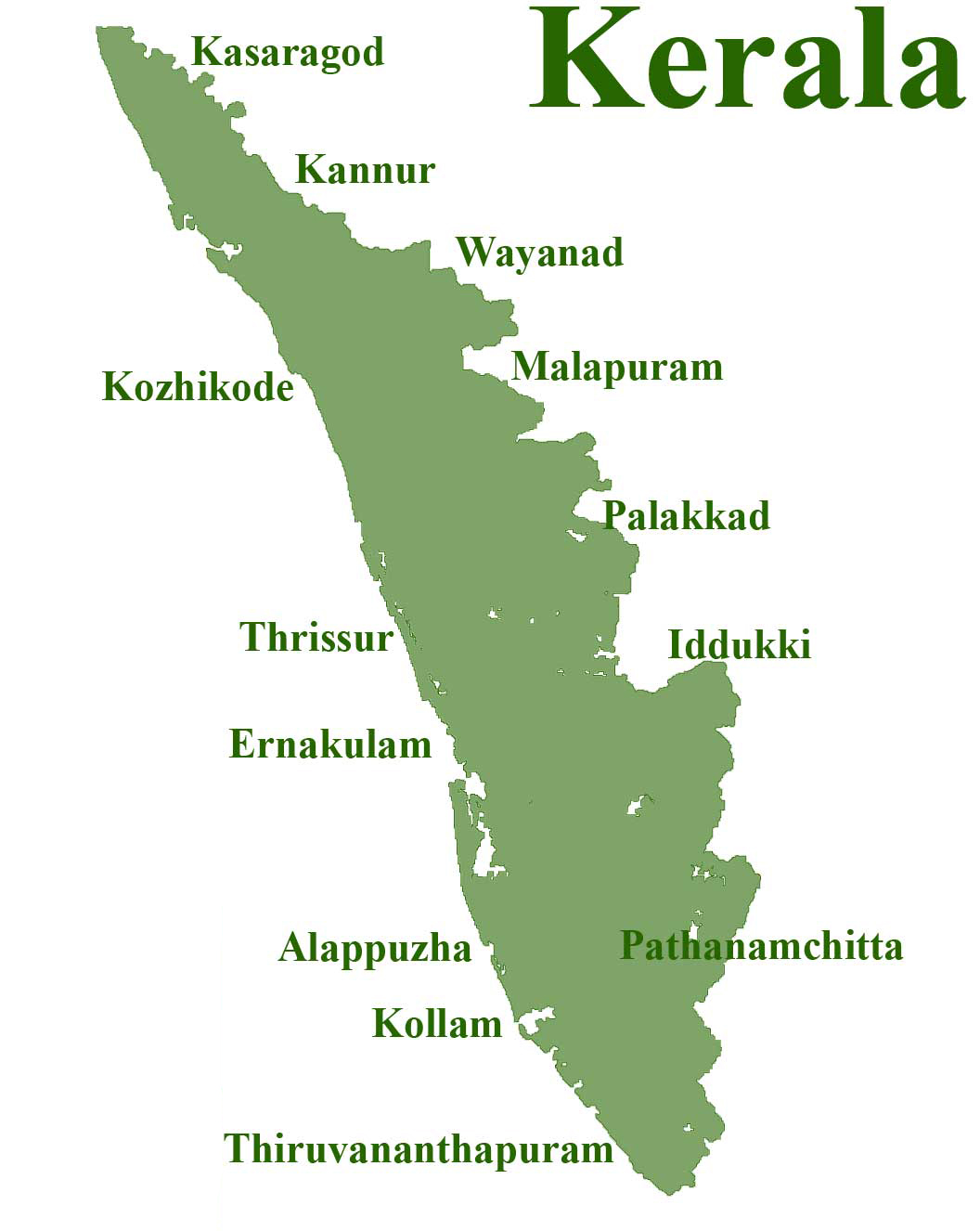Kerala is one of the smallest states of India. It spans an area of around
38,863 km2 contributing only 1.3% of the total area of India. It comprises of a
narrow coastal strip bounded by the Western Ghats in the east and the Arabian
Sea also called the Lakshadweep Seaon the west. This fertile coastal strip
is about 550km long and not wider than 100 km.
The state of Kerala is bordered by the state of Karnataka in the north, and joined by
the state of Tamil Nadu in the
south. It lies between 8° 18' North Latitude and between 74° 52' and 77° 24'
East Longitude.
Located at the extreme southerntip of the Indian subcontinent, Kerala lies near the center of the Indian
tectonic plate (the Indian Plate) and most of the state is subject to
comparatively little seismic or volcanic activity. Geologically, pre-Cambrian
and Pleistocene formations comprise the bulk of Kerala’s terrain.
The topography consists of a hot and wet coastal plain
gradually rising in elevation to the high hills and mountains of the Western
Ghats.
According to Indian Mythology, Lord Vishnu descended from
the heavens in his incarnation of Parashuram.
After slaying the evil kings 21 times, he did penance for waging the terrible
war, and threw his axe into the sea. The area where the axe landed, from shaft
to blade, rose from the sea as Kerala, a land of plenty and prosperity. As a
narrow strip of land ensconced between the Arabian Sea and the Western Ghats,
Kerala has considerably influenced the course of its history due to its
geographical position.
Kerala is described as the favorite child of nature. Like the state of Kashmir in the north, the
state of Kerala in the south is famous for its breath-taking natural beauty.
Physical features demarcate the state into three natural
divisions. They are
the lowlands
the midlands
the highlands
The Lowlands
Adjoining the sea, the lowlands of the coastline are
predominantly sandy, with coconut palms and mangroves lining the white beaches,
and patchworks of rice fields fringing the river deltas and backwaters.
Fisheries and coif industry constitute the major industries of this area.
The Midlands
Consisting of the undulating country east of the lowlands,
the midlands lie in the central hills with valleys, punctuated here and there
by isolated hills. This rich and fertile
region bears the largest extent of agricultural crops. The lush valleys are sown with tea, coffee and
spices. Extensive tea and cardamom plantation dominate in the higher
elevations, while ginger, rubber, pepper, and turmeric flourish at the lower elevations. The cardamom takes its
name from the Cardamom hills of Kerala.
The Highlands
The forest-clad highlands on the extreme east are a a range
of forested mountains averaging 1000m in height, but reaching 2690m at Mt.
Anamudi, which is the highest peak in the region.
The hilly portion is broken up by long spurs, dense forests
and tangled jungles. The hills of Kerala dot the Western Ghat from Ponmudi in the
south to Munnar in the centre and
Sultan's Bathery in the north. These Western Ghats that range along the
highland are called Sahyadris which rise in elevation between 3,000 feet and
8,000 feet above sea-level. They form a natural wall of protection to the
state.
The Agastyakutam, connected to Sage Agastya of the Mahabharata tradition, is 6,132 feet
above sea-level. Much of the interior is covered with thick forests sprouting
some six hundred varieties of trees, including valuable timber. Most of these are
evergreen or semi-evergreen, including teak, mahogany, banya (fig), eucalyptus
and oak. The wanton growth of trees makes Kerala a herbarium. The four
month-long, copious monsoon and recurrent flurry make this land a perfect
nursery for all living beings.
It has one of the
richest varieties of flora and fauna in India
and they are also the best managed in the country. There are over 15,000 plant
species contributing to the 25% of the total plant species in India. These
include grasses, orchids, spices and medicinal plants. Kerala also has a rich
animal life. There are some 100 mammal species, including copious elephants and
monkeys, 550 bird species and 169 reptile species in its wetlands.
The Eravikulam,
the Periyar, and the Silent Valley
are the three national parks in the state. Kerala being a water place has
around 45 rivers and 1900 kms of interconnecting lakes and lagoons known as thebackwaters. Being an attractive,
economically valuable feature of Kerala, backwaters include lakes and ocean in
lets which stretch irregularly along the Kerala coast.
The biggest among these backwaters is the Vembanad lake,
with an area of 200 sq km, which opens into the Arabian Sea at Cochin port. The
other important backwaters are Veli, Kadhinam kulam, Anjengo (Anju Thengu),Edava,
Nadayara, Paravoor. Ashtamudi (Quilon). The most important of Kerala’s 45
rivers include the Periyar (244 km in length), the Bharathapuzha (209 km), the
Pamba (176 km), the Kadalundipuzha (130 km), and the Achancoil (128 km).
Kerala also has the famous Sabarimala which is the hallowed
seat of the Lord Ayyappan of pilgrimages.
Malayatoor hill has the popular St. Thomas Church. The
Ezhimala or Mount Eli, the conspicuous hill overlooking the Arabian Sea or the
Cannanore Coast, was the seat of a powerful kingdom and a landmark for mariners
in the early centuries of Christianity.
The Puralimala in Tellicherry Taluk was the center of the
Pazhassi revolt (1793-97; 1800-1805) against the British in the nineteenth
century.
The continuity of the Sahyadri hills is interrupted by the
presence of several gaps which have prevented the total isolation of Kerala
from the eastern countries.
The major gap is the Palghat Gap which is about 20 miles
wide. In addition to the Palghat Gap, there are others like the Perambadi Ghat
linking Kerala and Coorg, the Perlya and Thamarasseri Gaps linking Wynad and
Mysore, and Bodinayikannur, Kambam, Aryankavu, and Aramboli Passes connecting
Kerala and Tamil Nadu. In addition there are several large and historic cities,
some of them form the imperial trading posts built on the coast but now cut off
from it by centuries of river deposits.
Ports such as Cranganore, Quilon, Alleppey, Cannanore, and Cochin
became prominent in later Kerala history. Most of the ancient port cities,
except Cochin, are on the decline due to the lack of docking and berthing
facilities as well as the expansion of other ports like Bombay and Goa.
Agriculture contributes most to the state's income in the
primary sector. Kerala's major sources of exports are agro-based and
traditional like coir and cashew as well as marine products and manpower.
In spices, pepper is the single most important product,
with Kerala being the largest producer and exporter of black pepper. Cardamom
and ginger are also exported.
Join Us
















